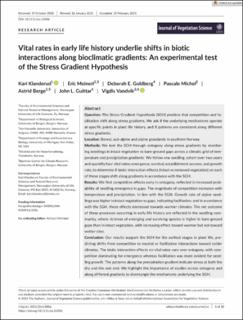| dc.contributor.author | Klanderud, Kari | |
| dc.contributor.author | Meineri, Eric Pierre F | |
| dc.contributor.author | Goldberg, Deborah E. | |
| dc.contributor.author | Michel, Pascale | |
| dc.contributor.author | Berge, Astrid | |
| dc.contributor.author | Guittar, John L. | |
| dc.contributor.author | Vandvik, Vigdis | |
| dc.date.accessioned | 2022-04-11T11:54:48Z | |
| dc.date.available | 2022-04-11T11:54:48Z | |
| dc.date.created | 2021-06-28T19:38:26Z | |
| dc.date.issued | 2021 | |
| dc.identifier.issn | 1100-9233 | |
| dc.identifier.uri | https://hdl.handle.net/11250/2990936 | |
| dc.description.abstract | Question
The Stress Gradient Hypothesis (SGH) predicts that competition and facilitation shift along stress gradients. We ask if the underlying mechanisms operate at specific points in plant life history, and if patterns are consistent along different stress gradients.
Location
Boreal, sub-alpine and alpine grasslands in southern Norway.
Methods
We test the SGH through ontogeny along stress gradients by monitoring seedlings in intact vegetation vs bare-ground gaps across a climatic grid of temperature and precipitation gradients. We follow one seedling cohort over two years and quantify four vital rates; emergence, survival, establishment success, and growth rate, to determine if biotic interaction effects (intact vs removed vegetation) on each of these stages shift along gradients in accordance with the SGH.
Results
We find competitive effects early in ontogeny, reflected in increased probability of seedling emergence in gaps. The magnitude of competition increases with temperature and precipitation, in line with the SGH. Growth rate of alpine seedlings was higher in intact vegetation vs gaps, indicating facilitation, and in accordance with the SGH, these effects decreased towards warmer climates. The net outcome of these processes occurring in early life history are reflected in the seedling community, where richness of emerging and surviving species is higher in bare-ground gaps than in intact vegetation, with increasing effect toward warmer but not toward wetter sites.
Conclusion
Our results support the SGH for the earliest stages in plant life, predicting shifts from competitive to neutral or facilitative interactions toward colder climates. The biotic interaction effects on vital rates vary over ontogeny, with competition dominating for emergence whereas facilitation was more evident for seedling growth. The patterns along the precipitation gradient indicate stress at both the dry and the wet end. We highlight the importance of studies across ontogeny and along different gradients to disentangle the mechanisms underlying the SGH. | en_US |
| dc.language.iso | eng | en_US |
| dc.publisher | Wiley | en_US |
| dc.rights | Attribution-NonCommercial-NoDerivatives 4.0 Internasjonal | * |
| dc.rights.uri | http://creativecommons.org/licenses/by-nc-nd/4.0/deed.no | * |
| dc.title | Vital rates in early life history underlie shifts in biotic interactions along bioclimatic gradients: An experimental test of the Stress Gradient Hypothesis | en_US |
| dc.type | Journal article | en_US |
| dc.type | Peer reviewed | en_US |
| dc.description.version | publishedVersion | en_US |
| dc.rights.holder | Copyright 2021 The Author(s) | en_US |
| dc.source.articlenumber | e13006 | en_US |
| cristin.ispublished | true | |
| cristin.fulltext | original | |
| cristin.qualitycode | 1 | |
| dc.identifier.doi | 10.1111/jvs.13006 | |
| dc.identifier.cristin | 1919122 | |
| dc.source.journal | Journal of Vegetation Science (JVS) | en_US |
| dc.relation.project | Norges forskningsråd: 274712 | en_US |
| dc.identifier.citation | Journal of Vegetation Science (JVS). 2021, 32 (2), e13006. | en_US |
| dc.source.volume | 32 | en_US |
| dc.source.issue | 2 | en_US |

